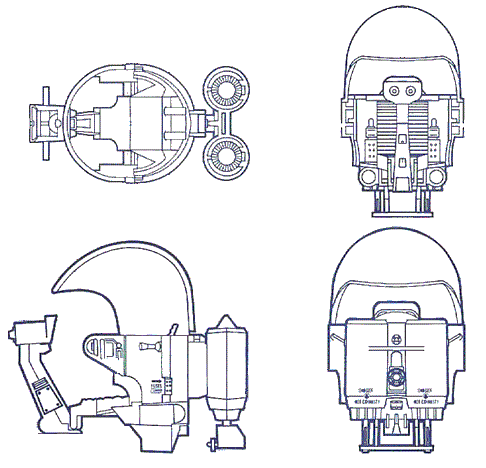
United Galaxies Council. | Individual Assault Pods
(aka "Trouble Bubbles"). | 
United Galaxies Council. |
|---|
 | | A Trouble Bubble. |
|---|
| Type: | One man flying platform. |
|---|
| Crew: | One only. |
|---|
Trouble Bubbles were developed by a collection of terrorist groups as flying machine gun nests; However, they were unwieldy, difficult to control once in the air, and the main gun would cause them to shake uncontrollably, and occasionally to crash.Though impractical for militry duties, the IAP did have many civilian applications, especially Urban Search And Rescue, where firefighters would climb into one, fly up four, five, ten, even twenty stories, insert into a building, then drag a victim to the IAP, hit a button marked "Go Home" (and upside down, so it was right side up from the firefighter's perspective), and away goes Little Susie, to the arms of waiting firefighters and paramedics, or mommy if she's still around. The Go Home feature was upgraded to a "Fetch" and "Retrieve" feature; Retrieve made the pod go back to the fire engines, Fetch made the pod go back to the spot where it was when the Retrieve was set (using GPS and low-power, terrain following radar) Another highly effective use was in construction: They were used to set tag lines, lift loads, give foremen and architects a birds-eye view, and anything else they can possibly imagine. This in fact aided reconstruction after the T'sentraedi Rain Of Death.Because of the difficulties of militry use, no combat related stats are listed here; However, because of their rousing success in SAR and Construction, those stats ARE listed. That's not to say there were no militry applications, just no GOOD ones; Many groups tried various gimmicks to militrize the IAP, most being dismal failures; One of the few success stories was the use of pre-programmed IAP's being used as missiles by a third-rate terrorist group. The organization was third rate, but the novel use of IAP's as GPS-accurized flying bombs made security managers globally very upset and concerned, and with good cause- The pods were cheap enough to be considered disposable, but heavy enough at speed to penetrate brick and metal skinned buildings. When rigged with an explosive package, they could have penetrated reinforced concrete, leaving dams extremely vulnerable.Type: One man flying platform.Crew: One only.SDC By Location: |
Main Body-
Control Yoke- | 50
15 | Engines (2)-
Plexi-Glass Hood- | 25 each
20 |
| Speed and Statistical Data: |
Top Speed: 25 mph.
Operational Ceiling: as much as 2,000 feet.
Width: 2.5 feet.
Length: 3 feet (5 with a gun).
Weight: 250 lbs; Two men can ussually lift and carry one without undue stress.
Cargo: 1 ton in underslung net only. | Power Plant: Twin jets; Exact type varied by owners.
Flight System: Downward thrust jets; Later on, grav pods were added.
Cost and Availability: 6,000credit; Takes about 2 days to assemble.
Black Market Cost and Availability: Could be as little as 10% to market value; They were easy to get, hard to get rid of.
|
| Weapons Systems: |
|---|
01. Water Cannon: The single best weapon ever mounted on the IAP was a water cannon; Firefighters would use this to blow out a window, flood out a room (to reduce the fire), then breach the building.
Purpose: Fire suppression.
Effect: 85% effective.
Rate Of Fire: 1 attack per melee, but it's a full melee attack.
Range: 50 feet max.
Payload: Semi-unlimited; The pod doesn't carry water itself, but pumps it in, usually from the fire engine. As long as the hose is intact, the pod still gets water, and the water cannon still sprays.
02. Hooks: Typically used by construction firms; They'd attach a hook anywhere they could find space. Stats were per the hooks, to a lift-load max of 2,000 lbs (1 ton) per pod. | 03. Machine Guns and Rockets/Missiles: It was done, but firing them caused the pod to shake so badly they couldn't hit the broadside of a barn from the inside.A few factions, mostly terrorists, actually armed these things, typically with medium auto cannons; One faction added an arial mine (basically a radar proximity activated oversized hand grenade held aloft by a lighter-than-air balloon) and a pair of SRM's. However, these are not listed HERE due to the wide breadth of variances in designed.The most heavily armed version seen to date used a pair of L-22's forward mounted with around 10,000 rounds and a quartet of SRM's.
|
| Features: |
- Radar: Civilian grade radar. Range: 20 miles, can track up to 25 individual targets. 80% reliability (00% against unfriendly stealthed vehicles).
- ESM: Radar Detector. Passively detects other radars being operated.
- Full Range Sensory Suite: Infrared, ultra violet, Magnification, night sight, color filters, thermal imager. Range is about 2,000 miles for MOST sensors.
- Type-11 wide band radios: Effective 10 mile range, auto encrypt/decrypt. Works on radio band wavelengths, so it can still be jammed (if the enemy knows the frequencies).
- Motion Detector: Activates a loud wailing when an object is coming at the user fast, and a soft ringing if it's coming slowly. Activation ranges must be specified by the pilot.
| - Blue Force Tracker: Identifies Friend from Foe. Overlays the information on both the radar and HUD, ensuring that friendly forces are not accidentally targeted.
- Loudspeaker: Amplifies voice 1 to 100 times. 100' in normal crowds.
- Video Recorder: Records from sensors and the cockpit itself. 500 hours of recording available.
- GPS: Standard tracking device.
- HUD: Displays maps, radar, targeting information, and any OTHER information the wearer wants directly in front of the user.
- Virtual Map: Displays a continuously-updating map of local terrain for the pilot. Effective land navigation of 85% as updates come. Good to 50 miles. Specific range can be adjusted in 1 mile increments.
- Variable Tint Cockpit Canopy: Adjusts tinting to light conditions, up to an including a black dot if the sun is directly on the pilots face (only covers eyes).
|
Combat Bonuses to the Individual Assault Pod: None. The IAP is pretty useless. |